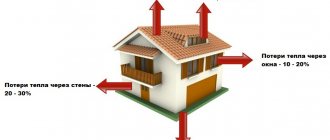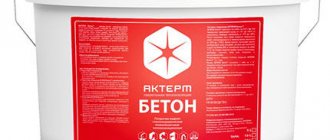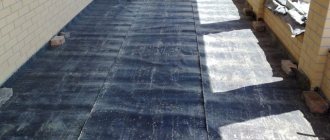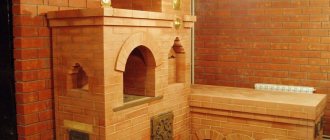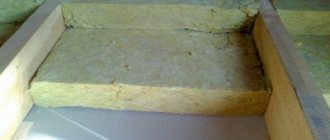Breakdowns often occur in the water supply and heating systems, so there is always a risk of water leakage. Agree, this can cause a lot of trouble, such as, for example, flooding someone else's apartment or destroying your own floor coverings. Also, do not forget that excess moisture can lead to the appearance of mold and mildew, which can negatively affect your health.
Therefore, it is necessary to take care of protection from moisture in advance, namely at the very beginning of the repair. To do this, the floor is waterproofed, which will serve as a reliable barrier from the effects of water.
Next, we will tell you how to independently carry out waterproofing work in an apartment, and also help you choose suitable materials.
The main advantages of floor waterproofing
Waterproofing is the protection of the concrete base, screed and front floor covering. Experts advise carrying out waterproofing immediately before screeding, since concrete can absorb moisture through micropores and subsequently collapse.
This is especially true for owners of first-floor apartments, since the screed is exposed to cold (from the basement) and warm (from the apartment) air currents.
Protecting the floor from moisture is necessarily used in the bathroom, toilet and kitchen, because all the plumbing is located there and there is the highest risk of flooding neighbors
However, the most reasonable option would be to waterproof the floor in the entire apartment, because:
- the solution used for floor screed contains water, so there is a risk of leakage to neighboring apartments located below;
- the heating system may fail, which will also lead to flooding of the lower floors;
- waterproofing will increase the strength and durability of the floor, protect against microcracks;
- When installing a heated floor system, waterproofing is required.
It is worth noting that waterproofing in areas located close to plumbing equipment must be especially carefully arranged.
Where to order
You can order floor waterproofing work, as well as purchase all the necessary materials, from the Moscow company Gidropro. The company has been operating on the market for more than 10 years and has many advantages: 1. Excellent quality of work and materials. 2. Prompt execution of orders. 3. Favorable prices. 4. Individual approach. 5. Providing advanced technologies.
Having used the services of the Hydropro company, most clients are satisfied with the results obtained and recommend the organization’s services to their family, friends and friends.
*************************************************************************************************************************
Each basic part of the room requires reliable protection from the influence of a humid environment. Failure to install waterproofing will result in deterioration of the concrete system and the formation of fungus on the wood of the floor.
Before installing the screed, it is necessary to properly waterproof the floor. This will help prevent water from entering from the lower floors. This will also reliably protect the floors and lower rooms from possible leaks and flooding.
It is extremely important to waterproof rooms located on the 1st floor and without a basement where concrete slabs are laid on the ground. Concrete, traditionally, has a porous structure and perfectly absorbs moisture from the ground. Regular exposure to moisture over time leads to the appearance of cracks and, as a result, to the destruction of the concrete base.

Selection of insulating materials
The building materials market offers a wide range of waterproofing for floor coverings, which differ depending on the method of application and area of use.
Let's take a closer look at the main types of waterproofing materials.
Rolled waterproofing materials
The basis of roll waterproofing is fiberglass or a mixture of polyester resins.
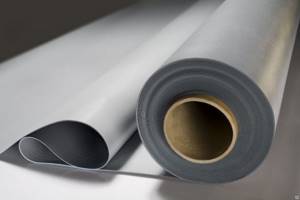
This type of material is sold in rolls and differs in the type of filling and method of fastening. The final layer combining the fillings is bitumen
Such coatings include hydroisol, isoplast, roofing material and the like.
Depending on the method of fastening, there are the following types of roll insulation:
- Adhesive . Attached using bitumen mastic or synthetic resin based adhesive. There are also self-adhesive options. The base must be well prepared. It is considered a simple option, as it does not require special skills.
- Weldable . The base is polyester or fiberglass. Using a gas burner or a heat gun, the bottom layer of insulation (bitumen) is melted and then installed. This method is not advisable to use in enclosed spaces, as bitumen vapors are toxic.
- Mechanically installed . The basis for this type is sand with a fine fraction or roofing felt. Fixed with self-tapping screws. This option is labor-intensive and not reliable enough.
The main reason for choosing roll-type waterproofing materials is the relatively low cost. Another advantage of roll coatings is the ability to immediately carry out further repair work.
The disadvantages include difficulty in installation in a small area, for example, in a bathroom.
It is also worth noting that during the installation of rolled waterproofing, seams are formed, which in the future may compromise the tightness of the protective coating.
Coating materials for waterproofing
Today, coating materials are the most popular materials for waterproofing, and in terms of their effectiveness they are replacing even rolled materials.
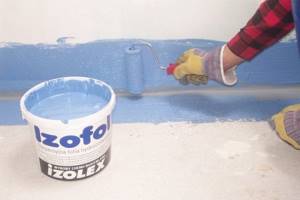
Ready-made liquid mastics are applied in several layers and completely cover the concrete surface, thereby effectively plugging all microcracks
After applying the mastic, a film is formed, which will serve as a protective barrier against unwanted moisture. Mastic materials for floor waterproofing are made on the basis of bitumen, acrylic and synthetic resins.
Depending on the constituent components and operational characteristics, there are several types of coating materials:
- Polymer cement mastics . They contain cement, fine quartz sand and polymer additives. The material has high adhesion and durability. The disadvantage is the drying time of the finished surface.
- Bitumen . Depending on the method of application, there are hot and cold application mastics. The latter option is better suited for waterproofing the floor in an apartment, since bitumen does not require heating to 160-180 °C, unlike hot-applied mastic.
- Polymerbitumen . Basically, compositions are produced based on the modification of bitumen with latex, polyurethane or acrylic. The materials have great strength along with high adhesion. They have a higher cost than previous types of mastics.
- Acrylic . Compared to bitumen materials, they are much more environmentally friendly and odorless. Suitable for underfloor heating systems. Their main disadvantage is their high cost.
Ready-made mastics and dry mixtures are available on the market. It is enough to dilute the latter with water according to the manufacturer’s instructions.

Dry mixtures for waterproofing, as a rule, are cheaper than ready-made liquid mastics, but a little more time will be spent preparing the mixture
When choosing a suitable mastic, it is necessary to take into account not only the price of the material, but also the indicated consumption per 1 m2. Often, inexpensive mastics are more viscous, which increases the material consumption declared by the manufacturer.
Penetrating compositions
The action of penetrating mixtures, so-called “impregnations,” is based on penetration into the structure of the concrete base and the ability to react with it.

After application, the mixture hardens, forming crystals inside the concrete that fill all the pores. Due to this, the base acquires a strong monolithic structure that is not susceptible to moisture.
Before applying impregnation, the concrete surface must be moistened. In addition, before using impregnation, preliminary application of a primer is not required, which will significantly reduce the cost of materials.
It should be noted that impregnation is not used on surfaces made of foam concrete, aerated concrete and brick, since the desired chemical reaction will not occur. The main disadvantage of the application is the high cost of materials.
Features of waterproofing in private houses and city apartments
Waterproofing a floor can be done in several common ways. If this procedure is carried out in rooms where there is no basement, you can build a cushion of sand and gravel.
- A layer of gravel and sand is poured onto the floor.
- All this is being compacted.
- Sand is poured on top.
A cushion of sand and gravel will prevent moisture from entering the apartment
This cushion will prevent water from seeping out of the soil. But it won’t save you from water vapor. Therefore, additional film insulation will have to be made. And waterproofing the floor in an apartment has a simpler procedure. There is no need to make a layer of sand and gravel. Or you can immediately begin laying the selected waterproof barrier.
When starting to lay the floor hydrobarrier in the apartment, level the surface with building mixtures. Rooms with high humidity levels require additional wall protection.
Before laying the waterproofing, the surface should be leveled
The procedure for carrying out waterproofing work
Almost all waterproofing methods include preparing the base, priming the surface and installing waterproofing materials. Let us consider the features of possible methods in more detail.
Method of roll floor waterproofing
First of all, it is necessary to prepare the surface, namely: dismantle the old coating to the concrete base, and also clean the floor from dust and debris.

Before using any method of waterproofing the floor and subsequent screed, it is necessary to eliminate cracks and cracks in the concrete base
When installing waterproofing in the bathroom and toilet, you will need to remove all plumbing equipment.
Of all the presented types of roll insulation for an apartment, it is advisable to choose the glued type of waterproofing.
After cleaning, the floor must be primed. The material is cut to the size of the room, leaving an overlap to overlap the walls - approximately 10 cm. The cut strips should be left on the floor for a day so that it is leveled.
The perimeter of the room is covered with special construction tape or waterproofing tape. The material is glued using glue or mastic on a polymer-bitumen basis. The prepared strips are overlapped on each other, at least 15 cm, while the joints of the strips are additionally glued with mastic.
There are also self-adhesive materials, which are easier to install because they do not require applying glue to the subfloor. You can install roll waterproofing using a roller or pressure roller.
Experts advise doing such waterproofing in two layers, one layer perpendicular to the other, after the previous one has dried.
Installation of coating waterproofing
Coating type waterproofing is considered the simplest insulation method.
As in the previous method, the base is prepared first. If a dry mixture is selected for work, then you need to prepare the solution according to the instructions indicated on the package.

Next, you need to apply a deep penetration primer, which will completely remove dust from the floor surface and ensure good adhesion of the floor base to the mastic
It is convenient to apply the mastic with a roller, after pouring it into the tray. All corners are worked with a brush.

The waterproofing tape must be unrolled around the perimeter of the room. Then coat the entire seam at the top and bottom of the tape with mastic.
The waterproofing material is applied in two layers. Interlayer drying between the first and second application is 2-4 hours. Repair work can be continued after the mastic has completely dried, approximately 10-15 hours.
Penetrating waterproofing technique
This method is considered the most effective, as it can withstand the results of even a serious pipeline break. Penetrating waterproofing also prevents corrosion of the reinforcement.
The execution method is similar to the previous method.

The penetrating floor waterproofing mixture is applied using a brush. No pre-treatment of the surface with a penetrating primer is required.
The drying time of the solution usually does not exceed one and a half hours, after which you can begin pouring the floor screed.
Why is vapor barrier needed?
Each house has its own specific microclimate inside. Here a person prepares food, takes a shower or bath, and does wet cleaning. Thanks to all these processes, a fairly large amount of steam is released into the air floating in the room, which tries to find a way out beyond the walls of the rooms. It has a fairly strong effect on all elements of the structure, and drops of moisture settle on the surface of the walls, ceiling, and inside the floor pie. The resulting condensate, willy-nilly, begins to penetrate into the structure of the materials used to build the house - it is absorbed into the wood, penetrates into the insulating layer, reducing the performance characteristics of the materials, destroying them.

Floor insulation
In rooms located on the first floors directly above the ground or basement, the floors also experience increased exposure to humidity. Here, moisture also affects the materials from below. And the vapor barrier is installed precisely with the aim of reducing the level of impact on the floors, while this type of material does not interfere with air circulation at all - its flows can easily go outside, the rooms will “breathe”.
On a note! Vapor barrier is especially necessary when building houses made of wood. However, it will not be superfluous when constructing concrete structures, since it will reduce the level of humidity in the building.
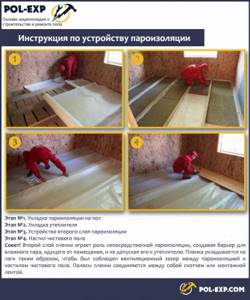
Instructions for installing a vapor barrier
Prices for vapor barrier film “Izospan”
vapor barrier film isospan
Conclusion

As a result of your efforts, you should get comfort and coziness in your home.
In this article, we figured out what it is to waterproof a floor in your own home. It is clear that its arrangement is a very responsible process. If such protection is not provided in a timely manner and with the highest quality, mold and other harmful microorganisms may appear in them during the operation of the premises.
In addition, moisture will gradually destroy the elements of the building and lead to frequent illnesses for the residents of the house. Therefore, think through all the stages of waterproofing in advance and complete them on time.

